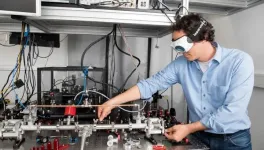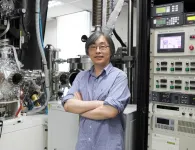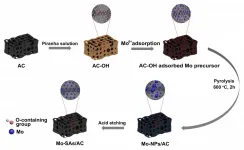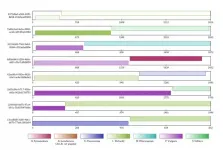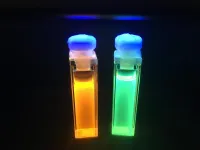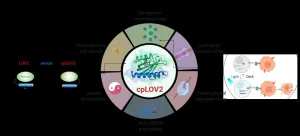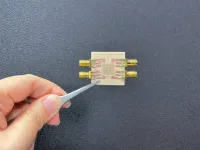(Press-News.org) Manufactured in a new process based on crystalline materials, these low-loss mirrors promise to open up completely new application areas, for example in optical respiratory gas analysis for early cancer detection or the detection of greenhouse gases. This work will be published in the current issue of the journal Optica.
In 2016 researchers at the LIGO laser interferometer succeeded in the first direct observation of gravitational waves, which had originally been predicted by Albert Einstein in 1916. A significant contribution to the observation of this wave-like propagation of disturbances in space-time, which was rewarded with the Nobel Prize a year later, was provided by the laser mirrors of the kilometer-long interferometer assembly. Optimization of these mirrors for extremely low optical absorption losses was a key advancement in realizing the sensitivity necessary to make such measurements. "Low-loss mirrors are a key technology for many different research fields," explains Oliver H. Heckl, head of the Christian Doppler Laboratory for Mid-IR Spectroscopy and Semiconductor Optics, "They are the link for such diverse research fields as cancer diagnosis and gravitational wave detection."
In fact, comparable mirror properties are also promising technological breakthroughs for significantly more practical applications. This includes, among other things, sensitive molecular spectroscopy, i.e. the detection of the smallest amounts of substances in gas mixtures - a research focus of the Christian Doppler Laboratory (CDL). Examples can be found in the early detection of cancer through the detection of the smallest concentrations of marker molecules in the breath of patients, or in the precise detection of methane leaks in large-scale natural gas production systems in order to limit the contribution of such greenhouse gases to climate change.
Unlike the experiments at LIGO, however, such investigations are conducted much further outside the visible light spectrum, in the mid-infrared range. In this wavelength region, also known as the "fingerprint region", many structurally similar molecules are clearly distinguishable on the basis of their characteristic absorption lines. Therefore, it is a longstanding wish of the photonics community, to realize similarly low loss levels in this technically challenging wavelength range.
This is exactly what the team led by Oliver H. Heckl has now achieved in an international cooperation. In this case, low loss means that the new type of mirror absorbs less than 10 out of a million photons. For comparison: A commercially available bathroom mirror "destroys" around ten thousand times more photons, and even the mirrors used in top research have ten to a hundred times higher losses.
This drastic improvement was made possible through the use of a completely new optical coating technology: First, single-crystal stacks of high-purity semiconductor materials are deposited via an epitaxial growth process. These monocrystalline multilayers are then transferred via a proprietary bonding process onto curved silicon optical substrates, completing the mirrors that were tested at both the CDL and NIST. This unique "crystalline coating" technology was developed and carried out by the industrial partner of the Christian Doppler Laboratory, Thorlabs Crystalline Solutions. This company was originally founded under the name Crystalline Mirror Solutions (CMS) in 2013 as a spin-off from the University of Vienna by Garrett Cole and Markus Aspelmeyer. CMS was acquired by Thorlabs Inc. in December 2019. This industry collaboration was made possible, with the support of the Federal Ministry for Digital and Economic Affairs, via the internationally unique model of the Christian Doppler Research Association (CDG) to promote application-oriented basic research. A research group led by Adam Fleisher from the National Institute for Standards and Technology (NIST) in Gaithersburg, Maryland (USA), which is renowned for precision measurements, also played a key role in this success. Georg Winkler, co-author of the current study expresses his enthusiasm: "Precise measurement technology is much more than just pedantry. Wherever you can take a closer look by an order of magnitude, you usually discover completely new phenomena, just think of the invention of the microscope and telescope!"
In fact, this assessment has already proven true in the detailed characterization of the new mirrors themselves, when a previously unknown effect of polarization-dependent absorption was discovered in the semiconductor layers and theoretically explored by collaborator Prof. Hartwin Peelaers at the University of Kansas. "These results open up great opportunities regarding further refinement of these mirrors ", co-author Lukas Perner is delighted: "Thanks to the extremely low losses can we now further optimize the bandwidth and reflectivity."
With this in mind, the project partners are already working on a further improvement of the technology: Expansion of the optical bandwidth of the mirrors will allow them to be used efficiently with so-called optical frequency combs. This will enable the analysis of particularly complex gas mixtures with unprecedented accuracy.
INFORMATION:
Publication in Optica: "Mid-infrared interference coatings with excess optical loss below 10 ppm", G. Winkler, L. W. Perner, G.-W. Truong, G. Zhao, D. Bachmann, A. S. Mayer, J. Fellinger, D. Follman, P. Heu, C. Deutsch, D. M. Bailey, H. Peelaers, S. Puchegger, A. J. Fleisher, G. D. Cole and O. H. Heckl, Optica, May 2021; DOI: 10.1364/OPTICA.405938
Spintronics is an emerging technology for manufacturing electronic devices that take advantage of electron spin and its associated magnetic properties, instead of using the electrical charge of an electron, to carry information. Antiferromagnetic materials are attracting attention in spintronics, with the expectation of spin operations with higher stability. Unlike ferromagnetic materials, in which atoms align along the same direction like in the typical refrigerator magnets, magnetic atoms inside antiferromagnets have antiparallel spin alignments that cancel out the net magnetization.
Scientists have worked on controlling the alignment of magnetic atoms within antiferromagnetic ...
In today's plants, photorespiration dissipates some of the energy produced by photosynthesis and releases CO2. It begins when the enzyme RuBisCO acts on oxygen instead of carbon dioxide and creates toxic side-products requiring costly recycling reactions. The detoxification process uses up fixed carbon and wastes energy, thus strongly limiting agricultural productivity.
Scientists generally pursue two approaches to minimizes the deleterious effects of photorespiration: mimic the carbon concentrating mechanism of C4 plants or introduce new metabolic pathways to bypass the photorespiration.
Researchers led by Andreas Weber from Heinrich ...
In a recent research, researchers led by Prof. ZHANG Haimin from the Institute of Solid State Physics of the Hefei Institutes of Physical Science (HFIPS) realized the synthesis of Mo single atoms anchored on activated carbon (Mo-SAs/AC) by the formed Mo-Ox bonds. The result was published on Chemical Communications.
According to the researchers, this new oxygen-coordinated molybdenum single atom catalyst was proved efficient to electrosynthesis of ammonia. The O-coordinated environment in this study, different from N-coordinated environment reported before, provided the sites to anchor Mo single atoms and form Mo-Ox sites, which could be used as the active centers for the adsorption and activation of N2, resulting in high ...
A new software tool developed by Earlham Institute researchers will help bioinformaticians improve the quality and accuracy of their biological data, and avoid mis-assemblies. The fast, lightweight, user-friendly tool visualises genome assemblies and gene alignments from the latest next generation sequencing technologies.
Called Alvis, the new visualisation tool examines mappings between DNA sequence data and reference genome databases. This allows bioinformaticians to more easily analyse their data generated from common genomics tasks and formats by producing efficient, ready-made vector images.
First author and post-doctoral scientist at the Earlham Institute Dr Samuel Martin in the Leggett Group, said: "Typically, alignment tools output plain ...
One day in the near future dyes in electric motors might indicate when cable insulation is becoming brittle and the motor needs replacing. Scientists at Martin Luther University Halle-Wittenberg (MLU), together with ELANTAS, a division of the specialty chemicals group ALTANA, have developed a new process that enables the dyes to be directly integrated into the insulation. By changing colour, they reveal how much the insulating resin layer around the copper wires in the motor has degraded. The results were published in the journal "Advanced Materials".
Modern combustion engines have long had detectors that recognise, for example, when an oil change is needed, saving unnecessary inspections. Electric motors also show signs of wear. Inside, ...
Combining natural salt marsh habitats with conventional dikes may provide a more sustainable and cost-effective alternative for fully engineered flood protection. Researchers of the University of Groningen (UG) and the Royal Netherlands Institute for Sea Research (NIOZ) studied how salt marsh nature management can be optimized for coastal defence purposes. They found that grazing by both cattle and small herbivores such as geese and hare and artificial mowing can reduce salt marsh erosion, therefore contributing to nature-based coastal defence.
People around the world live in coastal areas that are ...
Recently, Prof. WANG Junfeng from the High Magnetic Field Laboratory of the Hefei Institutes of Physical Science (HFIPS), together with international scholars, developed a novel circular permutated light-oxygen-voltage 2 (LOV2) to expand the repertoire of genetically encoded photoswitches, which will accelerate the design of novel optogenetic devices. The result was published in Nature Chemical Biology.
LOV2 domain is a blue light-sensitive photoswitch. In a typical LOV2-based optogenetic device, an effector domain is fused after the C-terminal Jα helix of LOV2, intending to cage the effector via steric hindrance in the dark. On photostimulation, light-triggered unfolding of the Jα helix exposes the effector domain to restore its function. Crafting a LOV2-based ...
With the rise of the digital age, the amount of WiFi sources to transmit information wirelessly between devices has grown exponentially. This results in the widespread use of the 2.4GHz radio frequency that WiFi uses, with excess signals available to be tapped for alternative uses.
To harness this under-utilised source of energy, a research team from the National University of Singapore (NUS) and Japan's Tohoku University (TU) has developed a technology that uses tiny smart devices known as spin-torque oscillators (STOs) to harvest and convert wireless radio frequencies into energy ...
A new study may have uncovered why wall lizards have become the most successful reptile in the Mediterranean region. The results reveal how drastic changes in sea levels and climate 6 million years ago affected species formation in the area. The researchers believe they can now explain why the lizards became so diverse and widespread, something that has puzzled biologists since the 19th century. The study is published in Nature Communications.
The evolution of wall lizards offers clues on how major events in the Mediterranean climate and geology millions of years ago affected how species formed or became extinct, and also paved the way for biodiversity.
Wall lizards date back around 20 million years. However, ...
A University of Surrey project has revealed innovative methods that could dramatically improve the performance of future electrical vehicles (e-vehicles).
As part of the European Union's STEVE* project, Surrey has developed several pioneering approaches to torque vectoring in electric vehicles.
In e-vehicles with multiple motors, it is possible to deliver different amounts of drive power to each wheel. This benefits the vehicles' power consumption, safety and driveability. The process of calculating and optimising the precise amount of power needed while the vehicle ...
